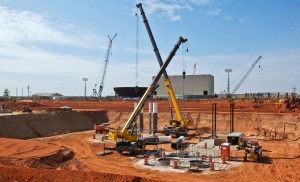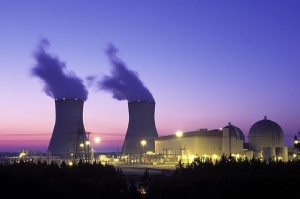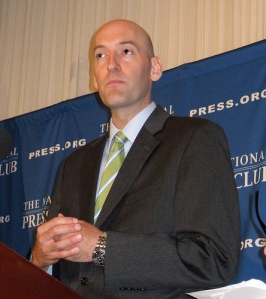You know that expression, “Hotter than July?” Well, this July, July was hotter than July. Depending on what part of the country you live in, it was upwards of three degrees hotter this July than the 20th Century average. Chicago, Denver, Detroit, Indianapolis and St. Louis are each “on a pace to shatter their all-time monthly heat records.” And “when the thermometer goes way up and the weather is sizzling hot,” as the Cole Porter song goes, demand for electricity goes way up, too.
During this peak period, wouldn’t it be great to know that you can depend on the expensive infrastructure your government and, frankly, you as ratepayers and taxpayers have been backstopping all these years? Yeah, that would be great. . . so would an energy source that was truly clean, safe, and too cheap to meter. Alas, to the surprise of no one (at least no one who watches this space), nuclear power, the origin of that catchy if not quite Porter-esque tripartite promise, cannot.
Take, for example, Braidwood, the nuclear facility that supplies much of Chicago with electricity:
It was so hot last week, a twin-unit nuclear plant in northeastern Illinois had to get special permission to continue operating after the temperature of the water in its cooling pond rose to 102 degrees.
It was the second such request from the plant, Braidwood, which opened 26 years ago. When it was new, the plant had permission to run as long as the temperature of its cooling water pond, a 2,500-acre lake in a former strip mine, remained below 98 degrees; in 2000 it got permission to raise the limit to 100 degrees.
The problem, said Craig Nesbit, a spokesman for Exelon, which owns the plant, is not only the hot days, but the hot nights. In normal weather, the water in the lake heats up during the day but cools down at night; lately, nighttime temperatures have been in the 90s, so the water does not cool.
But simply getting permission to suck in hotter water does not make the problem go away. When any thermoelectric plant (that includes nuclear, coal and some gas) has to use water warmer than design parameters, the cooling is less effective, and that loss of cooling potential means that plants need to dial down their output to keep from overheating and damaging core components. Exelon said it needed special dispensation to keep Braidwood running because of the increased demand for electricity during heat waves such as the one seen this July, but missing from the statement is that the very design of Braidwood means that it will run less efficiently and supply less power during hot weather.
Also missing from Exelon’s rationale is that they failed to meet one of the basic criteria for their exception:
At the Union of Concerned Scientists, a group that is generally critical of nuclear power safety, David Lochbaum, a nuclear engineer, said the commission was supposed to grant exemptions from its rules if there was no increase or only a minor increase in risk, and if the situation could not have been foreseen.
The safety argument “is likely solid and justified,’’ he wrote in an e-mail, but “it is tough to argue (rationally) that warming water conditions are unforeseen.’’ That is a predictable consequence of global warming, he said.
Quite. Lochbaum cites two instances from the hot summer of 2010–New Jersey’s Hope Creek nuclear station and Limerick in Pennsylvania each had to reduce output due to intake water that was too warm. In fact, cooling water problems at US thermoelectric generators were widespread along the Mississippi River during the hot, dry summer of 1988.
And the problem is clearly growing. Two months ago, a study published in Nature Climate Change predicted continued warming and spreading drought conditions will significantly reduce thermoelectric output in coming decades:
Higher water temperatures and reduced river flows in Europe and the United States in recent years have resulted in reduced production, or temporary shutdown, of several thermoelectric power plants, resulting in increased electricity prices and raising concerns about future energy security in a changing climate.
. . . .
[The Nature Climate Change study] projects further disruption to supply, with a likely decrease in thermoelectric power generating capacity of between 6-19% in Europe and 4-16% in the United States for the period 2031-2060, due to lack of cooling-water. The likelihood of extreme (>90%) reductions in thermoelectric power generation will, on average, increase by a factor of three.
Compared to other water use sectors (e.g. industry, agriculture, domestic use), the thermoelectric power sector is one of the largest water users in the US (at 40%) and in Europe (43% of total surface water withdrawals). While much of this water is ‘recycled’ the power plants rely on consistent volumes of water, at a particular temperature, to prevent overheating of power plants. Reduced water availability and higher water temperatures – caused by increasing ambient air temperatures associated with climate change – are therefore significant issues for electricity supply.
That study is of course considering all thermoelectric sources, not just nuclear, but the decrease in efficiency applies across the board. And, when it comes to nuclear power, as global temperatures continue to rise and water levels in rivers and lakes continue to drop, an even more disconcerting threat emerges.
When a coal plant is forced to shut down because of a lack of cool intake water, it can, in short order, basically get turned off. With no coal burning, the cooling needs of the facility quickly downgrade to zero.
A nuclear reactor, however, is never really “off.”
When a boiling water reactor or pressurized water reactor (BWR and PWR respectively, the two types that make up the total of the US commercial reactor fleet) is “shutdown” (be it in an orderly fashion or an abrupt “scram”), control rods are inserted amongst the fuel rods inside the reactor. The control rods absorb free neutrons, decreasing the number of heavy atoms getting hit and split in the fuel rods. It is that split, that fission, that provides the energy that heats the water in the reactor and produces the steam that drives the electricity-generating turbines. Generally, the more collisions, the more heat generated. An increase in heat means more steam to spin a turbine; fewer reactions means less heat, less steam and less electrical output. But it doesn’t mean no heat.
The water that drives the turbines also cools the fuel rods. It needs to circulate and somehow get cooled down when it is away from the reactor core. Even with control rods inserted, there are still reactions generating heat, and that heat needs to be extracted from the reactor or all kinds of trouble ensues–from too-high pressure breaching containment to melting the cladding on fuel rods, fires, and hydrogen explosions. This is why the term LOCA–a loss of coolant accident–is a scary one to nuclear watchdogs (and, theoretically, to nuclear regulators, too).
So, even when they are not producing electricity, nuclear reactors still need cooling. They still need a power source to make that cooling happen, and they still need a coolant, which, all across the United States and most of the rest of the world, means water.
Water that is increasingly growing too warm or too scarce. . . at least in the summer. . . you know, when it’s hot. . . and demand for electricity increases.
In fact, Braidwood is not the only US plant that has encountered problems this sultry season:
[A] spokeswoman for the Midwest Independent System Operator, which operates the regional grid, said that another plant had shut down because its water intake pipes were now above the water level of the body from which it draws its cooling water. Another is “partially curtailed.”
That spokeswoman can’t, it seems, tell us which plants she is talking about because that information “is considered competitive.” (Good to know that the Midwest Independent System Operator has its priorities straight. . . . Hey, that sounds like a hint! Anyone in the Midwest notice a nearby power plant curtailing operations?)
So, not isolated. . . and also not a surprise–not to the Nature Climate Change people this year, and not to the industry, itself. . . 17 years ago. The Electric Power Research Institute (EPRI), a non-profit group of scientists and engineers funded by the good folks who generate electricity (a group that has a noticeable overlap with the folks that own nuclear plants), released a study in 1995 that specifically warned of the threat a warming climate posed to electrical generation. The EPRI study predicted that rising levels of atmospheric carbon dioxide would make power production less efficient and more expensive, while at the same time increasing demand.
And climate predictions have only grown more dire since then.
Add to that mix one more complicating factor: when the intake water is warmer, the water expelled by the plant is warmer, too. And there are environmental protections in many areas that limit how hot that “waste” water can be. There have been instances in the past where thermoelectric plants have had to curtail production because their exhaust water exceeded allowable temperatures.
And yet, despite a myriad of potential problems and two decades of climate warnings, it is sobering to note that none of the US reactors were built to account for any of this. . . because all American nuclear reactors predate these revelations. That is not to say nuclear operators haven’t had 20 years (give or take) to plan for these exigencies, but it is to say that, by-and-large, they haven’t. (Beyond, that is, as described above, simply lobbying for higher water temperature limits. That’s a behavior all too recognizable when it comes to nuclear operators and regulators–when nuclear plants can’t meet requirements, don’t upgrade the procedures or equipment, just “upgrade” the requirements.)
But, rather than using all this knowledge to motivate a transition away from nuclear power, rather than using the time to begin decommissioning these dinosaurs, nuclear operators have instead pushed for license extensions–an additional 20 years beyond the original 40-year design. And, to date, the Nuclear Regulatory Commission has yet to reject a single extension request.
And now the nuclear industry–with the full faith and credit of the federal government–is looking to double down on this self-imposed ignorance. The “Advanced Passive” AP1000 reactors approved earlier this year for Georgia’s Plant Vogtle (and on track for South Carolina, too) may be called “advanced,” but they are still PWRs and they still require a large reserve of cool, circulating water to keep them operating and nominally safe.
The government is offering $8.3 billion of financing for the Georgia reactors at rock-bottom rates, and with very little cash up front from the plant owners. There have already been numerous concerns about the safety of the AP1000 design and the economic viability of the venture; factor in the impact of climate change, and the new Vogtle reactors are pretty much the definition of “boondoggle”–a wasteful, pointless project that gives the appearance of value while in reality delivering none. It is practically designed to fail, leaving the government (read: taxpayers and ratepayers) holding the bag.
But as a too-darn-hot July ends, that’s the woo being pitched by the nuclear industry and its government sweethearts. Rather than invest the money in technologies that actually thrive during the long, hot days of summer, rather than invest in improved efficiency and conservation programs that would both create jobs and decrease electrical demand (and carbon emissions), rather than seizing the moment, making, as it were, hay while the sun shines, it seems the US will choose to bury its head in the sand and call it shade.
Nuclear power was already understood to be dirty, dangerous and absurdly expensive, even without the pressures of climate change. Far from being the answer to growing greenhouse gas emissions, the lifecycle of nuclear power–from mining and milling to transport and disposal–has turned out to be a significant contributor to the problem. And now, the global weirding brought on by that problem has made nuclear even more precarious–more perilous and more pricy–and so an even more pernicious bet.
According to the Kinsey Report, every average man you know would prefer to play his favorite sport when the temperature is low. But when the thermometer goes way up and the weather is sizzling hot, a gob for his squab, a marine for his beauty queen, a GI for his cutie-pie–and now it turns out–the hour for nuclear power is not.
‘Cause it’s too darn hot.
It’s too. Darn. Hot.





You must be logged in to post a comment.